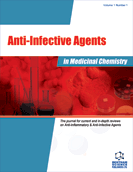Abstract
The emergence of nosocomial infections caused by methicillin-resistant Staphylococcus aureus (MRSA) and vancomycin-resistant Enterococci (VRE) has prompted research directed at the development of novel antibacterial agents to treat these diseases. This review will examine the literature on anti-MRSA and anti-VRE antibacterial research published between 2001 and October 2006.
Keywords: Chloroorienticin B, quinolone, natural products, linezolid, bacterial cell wall
Anti-Infective Agents in Medicinal Chemistry
Title: Antibacterial Agents Against Methicillin-Resistant Staphylococcus aureus (MRSA) and Vancomycin-Resistant Enterococci (VRE)
Volume: 6 Issue: 4
Author(s): Miguel O. Mitchell
Affiliation:
Keywords: Chloroorienticin B, quinolone, natural products, linezolid, bacterial cell wall
Abstract: The emergence of nosocomial infections caused by methicillin-resistant Staphylococcus aureus (MRSA) and vancomycin-resistant Enterococci (VRE) has prompted research directed at the development of novel antibacterial agents to treat these diseases. This review will examine the literature on anti-MRSA and anti-VRE antibacterial research published between 2001 and October 2006.
Export Options
About this article
Cite this article as:
Mitchell O. Miguel, Antibacterial Agents Against Methicillin-Resistant Staphylococcus aureus (MRSA) and Vancomycin-Resistant Enterococci (VRE), Anti-Infective Agents in Medicinal Chemistry 2007; 6 (4) . https://dx.doi.org/10.2174/187152107782023114
| DOI https://dx.doi.org/10.2174/187152107782023114 |
Print ISSN 1871-5214 |
| Publisher Name Bentham Science Publisher |
Online ISSN 1875-6018 |
 5
5Related Articles
-
QSAR Study on a Series of Aryl Carboxylic Acid Amide Derivatives as Potential Inhibitors of Dihydroorotate Dehydrogenase (DHODH)
Medicinal Chemistry Chemically Functionalized Carbon Nanotubes: Emerging Vectors for Cell Therapy
Mini-Reviews in Medicinal Chemistry Isoliquiritigenin Inhibits Proliferation and Induces Apoptosis via Alleviating Hypoxia and Reducing Glycolysis in Mouse Melanoma B16F10 Cells
Recent Patents on Anti-Cancer Drug Discovery Cannabinoids: Occurrence and Medicinal Chemistry
Current Medicinal Chemistry Synthesis of 4-piperidone Based Curcuminoids with Anti-inflammatory and Anti-Proliferation Potential in Human Cancer Cell Lines
Anti-Cancer Agents in Medicinal Chemistry Quantitative Evaluation of Micronuclei in Oral Squamous Cell Carcinoma and Oral Submucous Fibrosis Patients: A Comparative Study
Recent Patents on Anti-Cancer Drug Discovery Obesity and Inflammation: Colorectal Cancer Engines
Current Molecular Pharmacology A Tour of Unsupervised Deep Learning for Medical Image Analysis
Current Medical Imaging Pharmacokinetic Drug-drug Interaction of Antibiotics Used in Sepsis Care in China
Current Drug Metabolism Design, Synthesis and Evaluation of Hybrid 2-Heteroaryl Benzimidazole- Chalcone Derivatives as Anticancer Agents
Letters in Organic Chemistry Advances in Efficient Health Communication: Promoting Prevention and Detection of STDs
Current HIV Research Nano Carriers Based Approaches for Bioavailability Enhancement of Ora l Hypoglycaemic Agents
Drug Delivery Letters Hydroxytyrosol and Derivatives: Isolation, Synthesis, and Biological Properties
Current Organic Chemistry Recent Patents on Molecular Cytogenetics
Recent Patents on DNA & Gene Sequences Human Leukemia and Lymphoma Cell Lines as Models and Resources
Current Medicinal Chemistry Integrin (αvβ3) Targeted RGD Peptide Based Probe for Cancer Optical Imaging
Current Protein & Peptide Science Structure-Activity Relationships of Multidrug Resistance Reversers
Current Medicinal Chemistry Fluorescent Carbon Dots and their Applications in Sensing of Small Organic Molecules
Current Analytical Chemistry Categorization & Recognition of Lung Tumor Using Machine Learning Representations
Current Medical Imaging Isoprenoid Metabolism as a Therapeutic Target in Gram-Negative Pathogens
Current Topics in Medicinal Chemistry






















